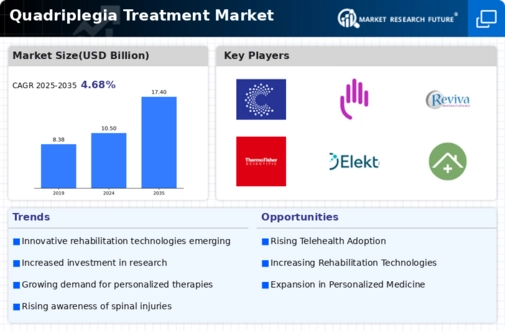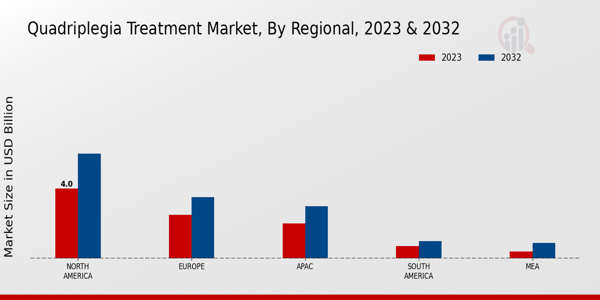Market Growth Projections
The Global Quadriplegia Treatment Market Industry is projected to experience substantial growth over the next decade. With a market value of 10.5 USD Billion in 2024, it is anticipated to reach 17.4 USD Billion by 2035. This growth trajectory indicates a compound annual growth rate of 4.68% from 2025 to 2035. Factors contributing to this expansion include advancements in medical technology, increasing government funding, and a rising awareness of spinal cord injuries. As the market evolves, stakeholders are likely to explore new avenues for innovation and collaboration, ensuring that the needs of quadriplegic patients are met effectively.
Growing Awareness and Advocacy
The Global Quadriplegia Treatment Market Industry is significantly influenced by growing awareness and advocacy for spinal cord injury treatment. Non-profit organizations and patient advocacy groups are actively promoting education about quadriplegia and the available treatment options. This heightened awareness leads to increased demand for specialized care and rehabilitation services. Furthermore, public campaigns aimed at reducing stigma associated with disabilities encourage more individuals to seek treatment. As awareness continues to expand, the market is likely to see a surge in patient engagement and participation in clinical trials. This trend could further stimulate innovation and development within the industry.
Advancements in Medical Technology
Technological advancements play a pivotal role in shaping the Global Quadriplegia Treatment Market Industry. Innovations in surgical techniques, neuroprosthetics, and rehabilitation devices enhance treatment efficacy and patient outcomes. For instance, the development of robotic exoskeletons and brain-computer interfaces has shown promise in improving mobility for quadriplegic patients. These advancements not only improve the quality of life but also attract investment in research and development. As the market evolves, the integration of artificial intelligence and telemedicine is likely to streamline treatment processes. This technological evolution is expected to contribute to a compound annual growth rate of 4.68% from 2025 to 2035.
Rising Incidence of Spinal Cord Injuries
The Global Quadriplegia Treatment Market Industry is experiencing growth due to the increasing incidence of spinal cord injuries. Factors such as road traffic accidents, falls, and sports-related injuries contribute significantly to this trend. In 2024, the market is projected to reach 10.5 USD Billion, reflecting the urgent need for effective treatment options. As awareness of rehabilitation therapies and assistive technologies rises, healthcare providers are likely to invest in innovative solutions. This growing patient population necessitates advancements in treatment modalities, thereby driving the market forward. The demand for specialized care and rehabilitation services is expected to increase, further propelling market growth.
Aging Population and Associated Health Issues
The aging population is a notable driver of the Global Quadriplegia Treatment Market Industry. As individuals age, the likelihood of experiencing health issues, including spinal cord injuries, increases. The demographic shift towards an older population necessitates enhanced healthcare services tailored to the needs of elderly patients. This trend is particularly relevant as the global population aged 65 and older is projected to grow significantly in the coming years. Consequently, healthcare providers are likely to focus on developing specialized treatment plans and rehabilitation programs for this demographic. The increasing prevalence of age-related conditions is expected to contribute to the overall growth of the market.
Increasing Government Initiatives and Funding
Government initiatives and funding are crucial drivers of the Global Quadriplegia Treatment Market Industry. Various countries are implementing policies to enhance healthcare access and improve treatment options for individuals with spinal cord injuries. For example, increased funding for rehabilitation programs and research grants supports innovation in treatment methodologies. Governments are also collaborating with private sectors to develop comprehensive care models that address the needs of quadriplegic patients. This collaborative approach is likely to lead to improved healthcare infrastructure and resources, ultimately benefiting the market. As a result, the market is expected to grow, reaching 17.4 USD Billion by 2035.












